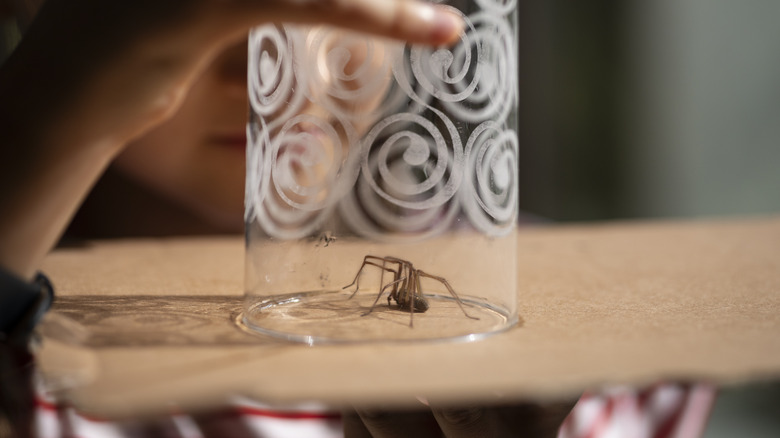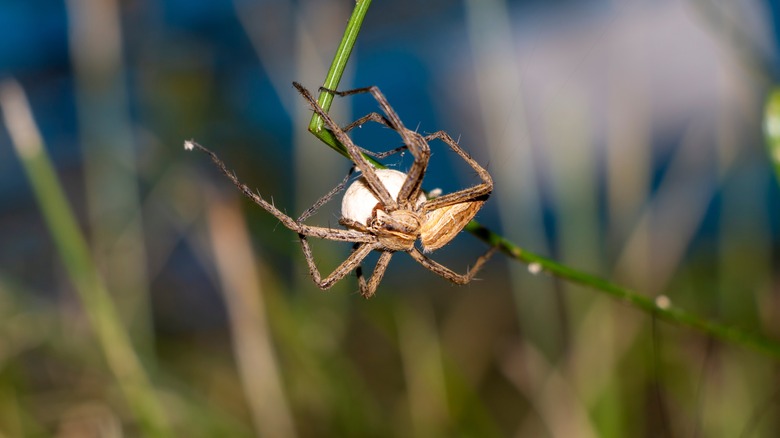The Poisonous Arachnid You Might Be Mistaking For A Wolf Spider
Whether you love them or hate them, spiders are a fact of life, and while they might be important in the environment, they're not so fun to discover in your home. If you've ever swept behind an old furniture piece or peered into a dusty corner, you're probably already familiar with several common types of spiders you might see in your home. The wolf spider is one formidable-looking arachnid, with a large, hairy body and the ability to dash up to 2 feet per second — enough to scare anyone out of their skin. But this spider is often blamed for more than its fair share of home invasions. There's another spider that you could mistake for a wolf spider if it wanders into your home: the nursery web spider (Pisaurina spp.).
The name "nursery" might make you think of tender baby blankets and cutesy décor, but there's nothing babyish about this relatively large arachnid. These spiders actually get their name from the way the mother spiders carry and protect their young, which would almost be sweet if they weren't, you know, spiders. Here are some key differences between wolf spiders and nursery web spiders, a look into whether these caring mothers are venomous, and what to do if you spot a nursery web spider in your home or yard.
The nursery web spider is a wolf spider look-alike
You hopefully already know how to tell the difference between a safe wolf spider and a dangerous brown recluse, but identifying nursery web spiders can be trickier. Nursery web spiders might look very similar to wolf spiders, but they're actually two different families, Pisauridae and Lycosidae, respectively. As a broad category, wolf spiders are usually tan or brown in color, with a slightly hairy appearance and darker streaks running down their body. Nursery web spiders are also brown but are less hairy and tend to be a more uniform shade, although they can have dark streaks on their body or legs. Adult nursery web spiders can be around 3 inches in length and may pose with two sets of legs stretched forwards and backwards while at rest, forming an X-shape.
Another key difference between wolf spiders and nursery web spiders is their behavior. Wolf spiders also carry their young, but female nursery web spiders are often seen using their jaws to carry an egg sac. Both of these spiders are ambush predators, so they don't build webs. Wolf spiders can usually be found scurrying along the ground in search of prey, while nursery web spiders are more likely to climb the leaves, grass, or other surfaces around them.
There's no need to fear this protective parent
Is the nursery web spider dangerous to people or pets? They might look scary, but these spiders are relatively non-aggressive and harmless to humans and pets. Nursery web spiders mostly use venom to incapacitate their prey, but just like wolf spiders, these spiders can bite if they feel threatened. Females are more likely to bite if they're defending their young. If you encounter one, avoid agitating the spider or picking it up with your bare hands, especially if it is a mother with an egg sac or spiderlings. Although a bite can hurt, most bites from a nursery web spider don't require any medical intervention.
You may see an increase in these interesting arachnids in the spring and early summer, when young adults are actively searching for mates, but their numbers don't usually constitute an invasion. Because they are generally harmless, there's no need to panic if you spot a nursery web spider in or around your home. Insecticides are not the best way to get rid of wolf spiders, and the same goes for nursery spiders. Nursery web spiders are not at risk of becoming endangered, so some experts aren't opposed to humans eliminating an individual spider if you must. However, if you can avoid squishing or spraying them, it is better to capture and release these gentle arachnids back outdoors, where they can serve their important role in the environment.


